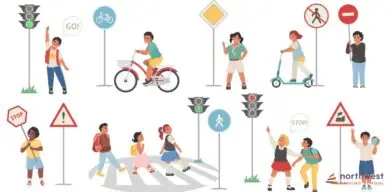- Traffic School
What Are Blind Spots In Driving? Tips On How To Avoid Them

Are you a student driver looking to understand what blind spots mean for drivers? Understanding the driving basics, including knowledge of blind spots, is key to your safety on the road.
Blind spots can easily remain hidden from a driver’s view, meaning they cannot be seen by simply glancing in the rearview or side mirrors.
Knowing about these specific areas of concern is essential to safely navigating other vehicles and pedestrians. So, read along as we dive deeper into what blind spot means for a driver and get more informed about important traffic awareness tips today!
Table of Contents
Definition Of Blind Spot
While driving, you may have heard the term “blind spot” but may not be sure about what it means. Simply put, a blind spot is an area surrounding your vehicle that cannot be seen in the rearview or side mirrors.
When a vehicle enters this area, it becomes invisible to the driver. Blind spots are dangerous and can lead to accidents if not handled properly. It’s essential to be aware of your blind spots and to make sure you check over your shoulder before changing lanes.
Failure to do so can result in collisions, particularly on freeways and highways where cars travel at high speeds. Understanding the concept of blind spots can help improve your driving experience and increase safety on the road.
Read More: What Is A Blind Spot?
Recognizing Your Blind Spots
Driving is a complex activity involving the coordination of many senses and cognitive abilities. One of the most essential skills for safe driving is recognizing blind spots. Blind spots occur when the driver’s field of vision is obstructed by other vehicles, objects, or even your own body.
To identify blind spots while driving, it’s crucial to regularly check your mirrors and physically turn around to look behind you when changing lanes or turning. Additionally, a well-placed convex mirror can help you see a broader range of views from your car.
Remember, recognizing blind spots is essential to prevent accidents and keep yourself and others safe on the road. Stay alert and take the necessary precautions to avoid potential hazards on the road.
Increasing Visibility
Regarding driving, visibility is key in ensuring your safety and the safety of others on the road. Several methods of increasing visibility include using your mirrors, having a good seating position, and adjusting your headrest.
Mirrors are essential in helping you keep track of what’s happening behind and beside your vehicle. By adjusting them correctly, you’ll have a wider field of vision and be able to spot potential hazards earlier.
A good seating position is also critical in maintaining visibility; ensure you sit straight and not too close to the steering wheel or dashboard.
Finally, adjusting your headrest can not only provide comfort and prevent neck strain, but it can also help prevent whiplash in the event of a rear-end collision. These simple steps can significantly increase your visibility while driving and help ensure a safer journey for everyone.
Reducing Blind Spots
Driving with blind spots can be a daily struggle for many drivers. Blind spots can occur in various places, including behind and beside your car. It can be dangerous to neglect these areas significantly when you are changing lanes or reversing your vehicle.
One possible solution is to avoid driving close to large vehicles, such as trucks or buses. These vehicles have more significant blind spots that can obstruct your car from view. Alternatively, consider installing blind spot mirrors on your car.
These mirrors can provide a better view of what’s happening around you and reduce the risk of an accident. Taking these small steps can help make your driving experience safer and more enjoyable.
How Technology Is Helping
Modern cars are no longer just a mode of transportation but also a hub of advanced technology. Blind-spot monitoring, a feature that helps drivers identify vehicles in their blindspots before changing lanes, is becoming increasingly common in modern cars.
Thanks to cameras and sensors, motion detection, and lane-assist technologies, drivers can rely on these smart and helpful features to alert them to potentially dangerous situations on the road.
Rearview cameras are a lifesaver in reversing, preventing drivers from accidentally backing into obstacles or pedestrians. With the advancements in technology, modern cars are becoming more intelligent, safer, and more intuitive with the needs of drivers on the road.
In conclusion, understanding blind spots and how to reduce their effects is essential for safe and confident driving. It is important for drivers to learn about blind spots, how to recognize them, how to increase visibility, ways of reducing them, and the technology available to help with this issue.
Knowing about these steps can improve a driver’s safety and the safety of others on the road. Ultimately, all drivers must understand the details of blindspots and be cognizant of their contributions to mitigating risk.
We at Northwest Driving School suggest that everyone practice safe driving habits as well as develop an understanding of blind spots so they can lessen their impact on their everyday driving experiences. We invite you to contact us today if you have any questions or would like to book your lessons!



